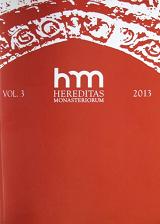Memoriał w sprawie klasztorów ks. Jana Kompałły z 1828 r. do Teofila Wolickiego, arcybpa archidiec. gnieźnieńskiej i poznańskiej, i jego konsekwencje
Fr. Jan Kompałła’s 1828 memorial concerning monasteries to Teofil Wolicki, archbishop of the Gniezno and Poznań archdiocese, and its consequences
Author(s): Dorota MatyaszczykSubject(s): History
Published by: Laboratoire de Recherches sur l'Histoire des Congregations et Ordres Religieux (LARHCOR)
Keywords: memorial; Fr. Jan Kompałła; archbishop Teofil Wolick;; Grand Duchy of Posen; Diocese of Poznań; dissolution of the monasteries; equipment of the parish churches; gymnasium in Ostrów Wielkopolski
Summary/Abstract: In the Archdiocesan Archive in Poznań, among the KA 10 969 records, an interesting document has been preserved. In October 1828 the Gniezno and Poznań metropolitan archbishop Teofil Wolicki received a lengthy letter from Fr. Jan Kompałła. The parish priest from Bukowice was requesting from the archbishop an intercession with the Prussian authorities in order for the property of dissolved monasteries to be bequeathed to the Catholic Church. In five well-grounded points, he presented reasons for which this property was not supposed to be handed over to the Protestants, as well as demonstrated how to utlise it practically. He suggested –among other things– that monastery buildings serve as lodgings for retired priests or impoverished families, and as institutes devoted to upbringing and education of children bourn out of wedlock. He intended the former Franciscan monastery in Grabów to be converted into a gymnasium for the Catholic youth. Education was meant to protect them from the partitioner’s endeavours to deprive them of the national identity. He was also asking the archbishop to elicit from the lay authorities the consent to move part of the equipment –even of the active monasteries– to poorer parish churches. He argued that these temples had been neglected for centuries, since the nobility had always been donating their lavish gifts exclusively to religious orders. Fr. Kompałła’s letter resulted in the Poznań Administrative Office’s directive no. 348 of 19 December 1828 and the Poznań Archiepiscopal Consistory’s directive no. 119 of 14 January 1829 sent to 22 deans in the territory of the Poznań diocese. They were instructed to gather information on what sort of equipment would be useful for the poor parish churches within the deaneries they were in charge of. Few were the parish priests who admitted that their temples did not need anything. The rest submitted lists –of various length– of the desired equipment. A tabular listing of the objects was sent to the Poznań Administrative Office by the consistory. These lists (collected in an thick cardboard-bound archival unit –poszyt– KA 12 236) were undoubtedly used afterwards to distribute the equipment of the dissolved monasteries.
Journal: Hereditas Monasteriorum
- Issue Year: 2013
- Issue No: 3
- Page Range: 301-322
- Page Count: 22
- Language: Polish

